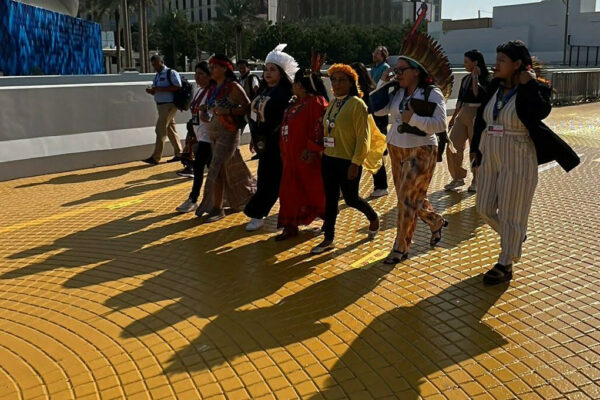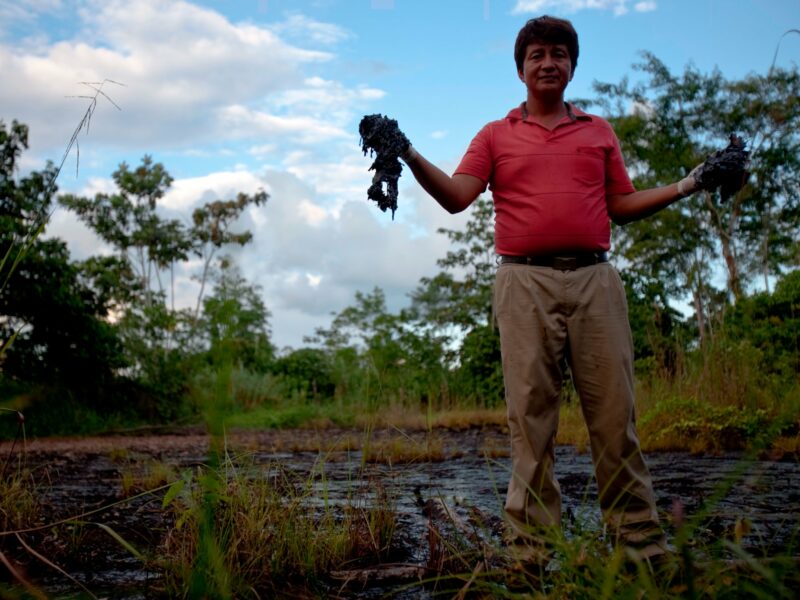Dureno Cofan, Ecuador – The jungle dwellers, barefoot and clad in tunics, thought a strange bird had dropped from the sky when the first Texaco helicopter touched down nearly four decades ago.
Creeping through the lush underbrush, the Cofan tribe members approached the strapping men descending from the helicopter in overalls and hard-hats, but they couldn’t communicate. So isolated was their corner of the Ecuadorean Amazon, the Cofanes didn’t speak Spanish, much less English.
The Texaco workers gave the Cofanes bread, cheese and diesel fuel. Those offerings, along with three spoons and plates, were the only gifts the Cofanes recall receiving from Texaco as the U.S.-based multinational corporation earned an estimated $30 billion from oil drilling in the Ecuadorean rainforest from 1970-90.
“They didn’t ask our permission to take the oil and they never paid us a penny for it,” recalled Emergildo Criollo, a Cofan leader.
The Cofanes are among five indigenous tribes and 80 local communities suing Texaco’s successor, ChevronTexaco, for allegedly contaminating the Ecuadorean Amazon and precipitating the demise of Amerindian groups during its oil operations.
As a result, the Cofanes’ population shrank from 15,000 in 1970 to less than 1,000 today, indigenous leaders say.
ChevronTexaco officials deny any wrongdoing and blame the damage on Ecuadorian government policies and subsequent operations by the state oil company. They also note that Texaco spent $13.3 million on water, sewage treatment and other public works projects for the Ecuadorean Amazon in the mid-1990s.
Some indigenous leaders concede additional factors may have contributed to their groups’ decline, from the lure of city life to government neglect to strict tribal laws that prompted young people to leave.
Wherever Ecuadorean courts ultimately place the blame, environmentalists and indigenous-rights groups cite Texaco’s operations in the Amazon as a cautionary tale. “No longer are indigenous people willing to let the multinationals decide what to do with our land and our resources,” said Luis Macas, president of the Confederation of Indigenous Nationalities of Ecuador.
However, tribal authority remains a gray area. Though since 1998 the Ecuadorian government has been required to consult with affected indigenous groups before approving oil projects, the state controls all natural resources.
When Texaco started exploring the Ecuadorean Amazon in the late 1960s, the Cofanes’ turf stretched for about 100 miles along both sides of the Rio Aguarico (Rich Water River), near Ecuador’s northern border with Colombia. The tribe survived by hunting and fishing, and rarely saw outsiders apart from missionaries.
That changed dramatically in 1972, when Texaco started operating the first of nearly 20 wells it would create in and around Cofan soil.
The first animals to die were the river dwellers, crocodiles and brilliantly colored water birds that went belly-up, coated in oily muck. Then the fish got sick. And so did the Cofanes, who used the rivers for drinking and bathing.
Meanwhile, mixed-race settlers from the south, encouraged by a government plan to develop the Amazon, arrived on Texaco’s new roads to turn jungle into ranches and farms.
Gradually, the Cofanes’ game began to vanish: boar and turkeys and monkeys and rodents that fled the noise and lights of people and pumps and processing plants. The Cofanes followed suit, scattering into 10 remote jungle settlements that constitute a fraction of their former lands.
“We thought we’d escape the contamination,” said Andrea Omenda, a 75-year-old shaman’s daughter who lives in one settlement, Dureno Cofan. “But the contamination followed us.”
At first glance, Dureno Cofan appears to be a jungle paradise. About 400 Cofanes live in wooden huts perched on stilts in a clearing reachable by canoe down a chocolate-colored river, followed by a mile’s walk through pebbled beach and undulating sugarcane.
Barefoot children chase pet dogs and old men hew canoes from cedar trunks. But many children are covered with rashes from bathing in rivers and streams, and the tribe subsists primarily on yucca and bananas.
Many young people wonder how long they can stay in the tribe. “I want to continue the tradition,” said Aristide Huikla, 13, whose attire included a New York Yankees cap and a traditional necklace of dried berries. “But with nothing to hunt or fish, how will I live?”













